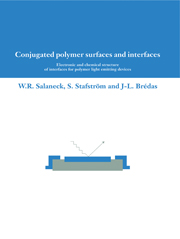 Conjugated Polymer Surfaces and Interfaces
Conjugated Polymer Surfaces and Interfaces Book contents
6 - Optical absorption and emission in conjugated oligomers and polymers
Published online by Cambridge University Press: 12 January 2010
Summary
In this section, the basic features of light absorption and emission (luminescence) processes in conjugated systems are reviewed. The discussion will focus on poly (p-phenylenevinylene), PPV, compounds, which provide typical examples of the physical phenomena to be highlighted in the context of polymer-based light emitting devices.
Optical absorption
In most cases, conjugated polymers present broad, inhomogeneous optical absorption bands that become more resolved when the material can be prepared in a more ordered way. This broadness originates in a number of features such as distribution of chain lengths, presence of chain bends, chain twists, or other defects, which contribute to the determination of an effective conjugation length. In the best-ordered PPV samples, the extent of effective conjugation length is estimated to be on the order of 15–20 phenylene vinylene units, by making comparison among a series of well-defined phenylene vinylene oligomers and PPV-based polymers.
Another most notable aspect relates to the vibronic coupling, that is the coupling between electronic excitations and vibrational modes. As has been stressed many times in the literature, much of the rich and fascinating physics of conjugated polymers is based on the strong connection between the electronic structure and the geometric structure: any electronic process (be it photoexcitation or charge transfer upon reduction, oxidation, or protonation i.e., doping, of the polymer chains) results in significant geometry relaxations that in turn modify the electronic properties.
- Type
- Chapter
- Information
- Conjugated Polymer Surfaces and InterfacesElectronic and Chemical Structure of Interfaces for Polymer Light Emitting Devices, pp. 72 - 83Publisher: Cambridge University PressPrint publication year: 1996
- 1
- Cited by


